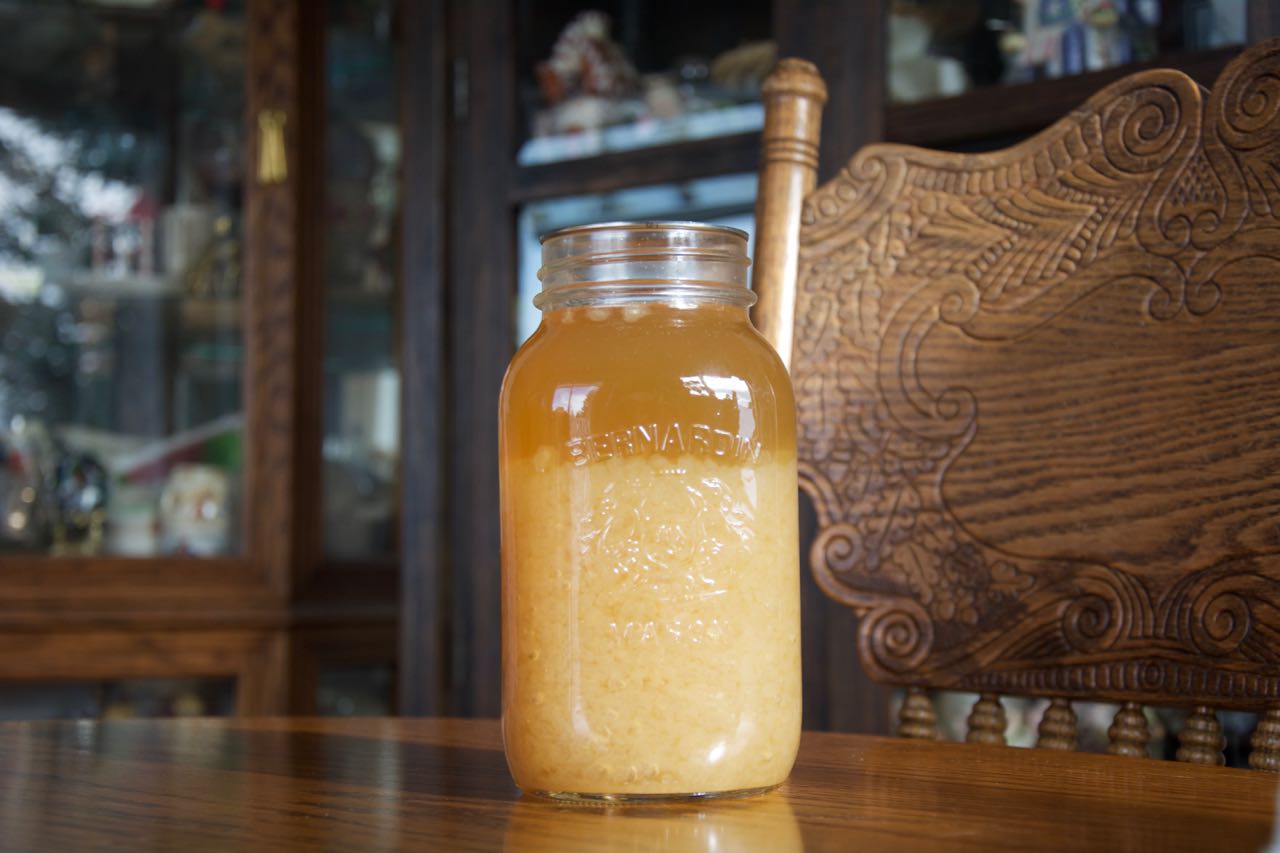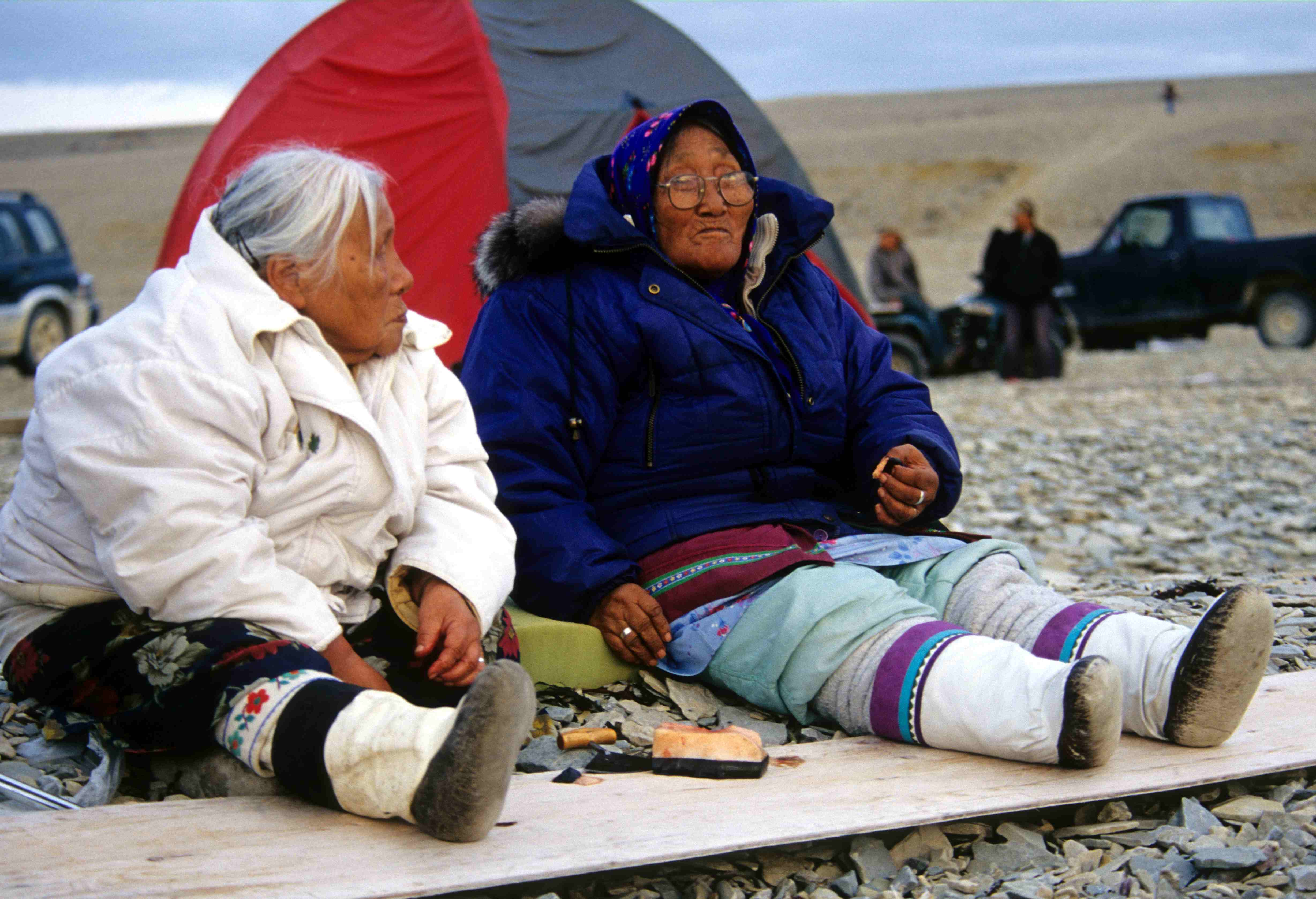|
Kiviak
Kiviak or kiviaq is a traditional wintertime Inuit food from Greenland that is made of little auks (''Alle alle''), a type of seabird, fermented in a seal skin. Making kiviak has traditionally been a community effort in Inughuit culture. Up to 500 whole auks are packed into the seal skin, beaks and feathers included. As much air as possible is removed from the seal skin before it is sewn up and sealed with seal fat, which repels flies. It is then hidden in a heap of stones, with a large rock placed on top to keep the air out. Over the course of three months, the birds ferment, and are then eaten during the Arctic winter, particularly on birthdays and weddings. The process was featured in the third episode of BBC's ''Human Planet'' in 2011. Polar explorer Knud Rasmussen's death is attributed to food poisoning by kiviaq. In August 2013 several people died in Siorapaluk from eating kiviak that was made from eider rather than auk. Eider does not ferment as well as auk, and t ... [...More Info...] [...Related Items...] OR: [Wikipedia] [Google] [Baidu] |
List Of Fermented Foods
This is a list of fermented foods, which are foods produced or preserved by the action of microorganisms. In this context, fermentation typically refers to the fermentation of sugar to alcohol using yeast, but other fermentation processes involve the use of bacteria such as lactobacillus, including the making of foods such as yogurt and sauerkraut. Many fermented foods are mass-produced using industrial fermentation processes. The science of fermentation is known as zymology. Many pickled or soured foods are fermented as part of the pickling or souring process, but many are simply processed with brine, vinegar, or another acid such as lemon juice. __TOC__ Fermented foods Fermented beans and seeds Fermented cheeses Most cheeses are fermented as part of their production. Fermented condiments Fermented creams and yogurts Fermented grains and grain-based foods Fermented fruits and vegetables Fermented meat and seafood Fermented drinks and ... [...More Info...] [...Related Items...] OR: [Wikipedia] [Google] [Baidu] |
Knud Rasmussen
Knud Johan Victor Rasmussen (; 7 June 1879 – 21 December 1933) was a Greenlandic-Danish polar explorer and anthropologist. He has been called the "father of Eskimology" (now often known as Inuit Studies or Greenlandic and Arctic Studies) and was the first European to cross the Northwest Passage via dog sled. He remains well known in Greenland, Denmark and among Canadian Inuit.Elizabeth Cruwys, 2003. Early years Rasmussen was born in Jacobshavn (now called Ilulissat), Greenland, the son of a Danish missionary, the vicar Christian Rasmussen, and an Inuit, Inuk–Danish mother, Lovise Rasmussen (née Fleischer). He had two siblings. Rasmussen spent his early years in Greenland among the Kalaallit where he learnt to speak Greenlandic language, Kalaallisut, hunt, drive dog sleds and live in harsh Arctic conditions. "My playmates were native Greenlanders; from the earliest boyhood I played and worked with the hunters, so even the hardships of the most strenuous sledge-trips b ... [...More Info...] [...Related Items...] OR: [Wikipedia] [Google] [Baidu] |
Siorapaluk
Siorapaluk ( West Greenlandic) or Hiurapaluk ( Polar Inuit) is a settlement in the Qaanaaq area of the Avannaata municipality in northern Greenland. The settlement is located in the northern shore of the Siorapaluup Kangerlua (Robertson Fjord). It has a population of 43 who speak the Inuktun language of the Polar Inuit as well as the Kalaallisut dialect of Greenlandic. Many of the inhabitants are direct descendants of the last migration of Inuit from Canada in the 20th century. Siorapaluk is the northernmost inhabited public settlement in Greenland, and one of the northernmost such settlements in the world, surpassed only by a few villages in Svalbard. It is also the world's northernmost place inhabited by natives. Geography Climate Hunting There is good hunting in the area of the settlement, and the cliffs around it function as breeding grounds for dovekie (UK English: little auk) ('' Alle alle'') and the thick-billed murre (UK English: Brünnich's guillemot) ('' Ur ... [...More Info...] [...Related Items...] OR: [Wikipedia] [Google] [Baidu] |
Inuit Cuisine
Historically, Inuit cuisine, which is taken here to include Greenlandic, Yupʼik and Aleut cuisine, consisted of a diet of animal source foods that were fished, hunted, and gathered locally. In the 20th century the Inuit diet began to change and by the 21st century the diet was closer to a Western diet. After hunting, they often honour the animals' spirit by singing songs and performing rituals. Although traditional or country foods still play an important role in the identity of Inuit, much food is purchased from the store, which has led to health problems and food insecurity. According to Edmund Searles in his article ''Food and the Making of Modern Inuit Identities'', they consume this type of diet because a mostly meat diet is "effective in keeping the body warm, making the body strong, keeping the body fit, and even making that body healthy". Food sources * Hunted meats: ** Sea mammals such as walrus, seal, and whale. Whale meat generally comes from the narwhal, beluga ... [...More Info...] [...Related Items...] OR: [Wikipedia] [Google] [Baidu] |
Greenlandic Cuisine
Greenlandic cuisine is traditionally based on meat from marine mammals, birds, and fish, and normally contains high levels of protein. Since colonization and the arrival of international trade, the cuisine has been increasingly influenced by Danish, British, American and Canadian cuisine."Greenlandic cuisine." ''Official Greenland Tourism Guide.'' (retrieved 30 Oct 2010) During the summer when the weather is milder, meals are often eaten outdoors."Traditional Greenlandic food." ''Official Greenland Tourism Guide.'' (retrieved 30 Oct 2010) National dish Th ...[...More Info...] [...Related Items...] OR: [Wikipedia] [Google] [Baidu] |
Meat Dishes
Meat is animal tissue, often muscle, that is eaten as food. Humans have hunted and farmed other animals for meat since prehistory. The Neolithic Revolution allowed the domestication of vertebrates, including chickens, sheep, goats, pigs, horses, and cattle, starting around 11,000 years ago. Since then, selective breeding has enabled farmers to produce meat with the qualities desired by producers and consumers. Meat is mainly composed of water, protein, and fat. Its quality is affected by many factors, including the genetics, health, and nutritional status of the animal involved. Without preservation, bacteria and fungi decompose and spoil unprocessed meat within hours or days. Meat is edible raw, but it is mostly eaten cooked, such as by stewing or roasting, or processed, such as by smoking or salting. The consumption of meat (especially red and processed meat, as opposed to fish and poultry) increases the risk of certain negative health outcomes including cancer, coron ... [...More Info...] [...Related Items...] OR: [Wikipedia] [Google] [Baidu] |
Botulism
Botulism is a rare and potentially fatal illness caused by botulinum toxin, which is produced by the bacterium ''Clostridium botulinum''. The disease begins with weakness, blurred vision, Fatigue (medical), feeling tired, and trouble speaking. This may then be followed by weakness of the arms, chest muscles, and legs. Vomiting, swelling of the abdomen, and diarrhea may also occur. The disease does not usually affect consciousness or cause a fever. Botulism can occur in several ways. The bacterial spores which cause it are common in both soil and water and are very resistant. They produce the botulinum toxin when exposed to low oxygen levels and certain temperatures. Foodborne botulism happens when food containing the toxin is eaten. Infant botulism instead happens when the bacterium develops in the intestines and releases the toxin. This typically only occurs in children less than one year old, as protective mechanisms against development of the bacterium develop after that age ... [...More Info...] [...Related Items...] OR: [Wikipedia] [Google] [Baidu] |
Eider
The eiders () are large seaducks in the genus ''Somateria''. The three extant species all breed in the cooler latitudes of the Northern Hemisphere. The down feathers of eider ducks and some other ducks and geese are used to fill pillows and quilts—they have given the name to the type of quilt known as an eiderdown. Taxonomy The genus ''Somateria '' was introduced in 1819 to accommodate the king eider by the English zoologist William Leach in an appendix to John Ross's account of his voyage to look for the Northwest Passage. The name is derived from Ancient Greek : ''sōma'' "body" (stem ''somat-'') and : ''erion'' "wool", referring to eiderdown. Steller's eider (''Polysticta stelleri'') is in a different genus despite its name. Species The genus contains three extant species. Two undescribed species are known from fossils, one from Middle Oligocene rocks in Kazakhstan and another from the Late Miocene or Early Pliocene of Lee Creek Mine, United States. ... [...More Info...] [...Related Items...] OR: [Wikipedia] [Google] [Baidu] |
Inuit
Inuit (singular: Inuk) are a group of culturally and historically similar Indigenous peoples traditionally inhabiting the Arctic and Subarctic regions of North America and Russia, including Greenland, Labrador, Quebec, Nunavut, the Northwest Territories, Yukon (traditionally), Alaska, and the Chukotsky District of Chukotka Autonomous Okrug. The Inuit languages are part of the Eskaleut languages, also known as Inuit-Yupik-Unangan, and also as Eskimo–Aleut. Canadian Inuit live throughout most of Northern Canada in the territory of Nunavut, Nunavik in the northern third of Quebec, the Nunatsiavut in Labrador, and in various parts of the Northwest Territories and Yukon (traditionally), particularly around the Arctic Ocean, in the Inuvialuit Settlement Region. These areas are known, by Inuit Tapiriit Kanatami and the Government of Canada, as Inuit Nunangat. In Canada, sections 25 and 35 of the Constitution Act of 1982 classify Inuit as a distinctive group of Abo ... [...More Info...] [...Related Items...] OR: [Wikipedia] [Google] [Baidu] |
Greenland
Greenland is an autonomous territory in the Danish Realm, Kingdom of Denmark. It is by far the largest geographically of three constituent parts of the kingdom; the other two are metropolitan Denmark and the Faroe Islands. Citizens of Greenland are full Danish nationality law, citizens of Denmark and European Union citizenship, of the European Union. Greenland is one of the Special territories of members of the European Economic Area#Overseas countries and territories, Overseas Countries and Territories of the European Union and is part of the Council of Europe. It is the List of islands by area, world's largest island, and lies between the Arctic Ocean, Arctic and Atlantic oceans, east of the Arctic Archipelago, Canadian Arctic Archipelago. It is the location of the northernmost point of land in the world; Kaffeklubben Island off the northern coast is the world's Northernmost point of land, northernmost undisputed point of land—Cape Morris Jesup on the mainland was thought to ... [...More Info...] [...Related Items...] OR: [Wikipedia] [Google] [Baidu] |
Human Planet
''Human Planet'' is an 8-part British television documentary series. It was produced as a co-production between the BBC Natural History Unit, BBC Worldwide, BBC Cymru Wales, Discovery Channel and France Télévisions. The documentary describes the human species and its relationship with the natural world by showing the remarkable ways humans have adapted to life in every environment on Earth. The show drew attention for alleged fakery and the BBC eventually acknowledged that a number of scenes were inaccurately depicted or misleading and withdrew the series from distribution. ''Human Planet'' was originally screened in the UK on BBC One each Thursday at 8pm over eight weeks, starting from 13 January 2011. Domestic repeats have been seen on Eden (British TV channel), Eden, with all 8 episodes aired over one week in April 2012. BBC Worldwide has since announced they have sold the broadcast rights to 22 international markets. Production Announced in 2007, the production teams base ... [...More Info...] [...Related Items...] OR: [Wikipedia] [Google] [Baidu] |




